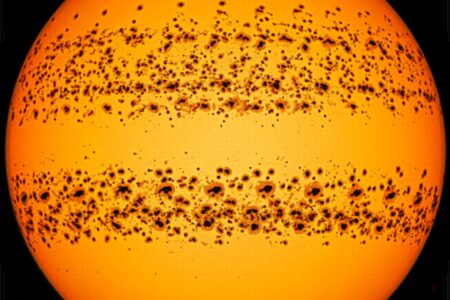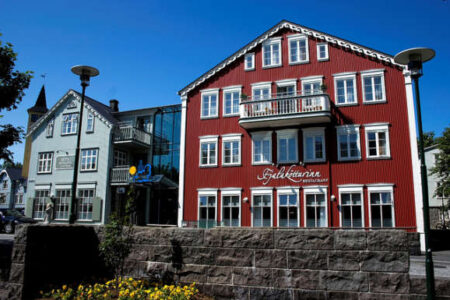Iceland is one of the best places to see the aurora borealis. During the northern lights season (from September to March), the dancing colours of the aurora regularly light up the skies.
But to have the best chances of seeing the northern lights on your aurora holiday, you need to escape to the dark skies of the Icelandic countryside.
Here, we look at the best northern lights locations in Iceland to help you plan your trip.
Can you see the northern lights in Iceland?
Yes, you can see the northern lights in Iceland. The country sits within the aurora zone, around 65 degrees north of the equator. Here, the aurora borealis shines with the greatest frequency and intensity.
However — while the northern lights occur regularly — they aren’t always visible. Bright city lights and rain clouds sometimes obscure them from view. So you have the best chances of seeing the northern lights in Iceland if you travel to remote areas, with clear skies and no artificial light.
Where to see the aurora borealis in Iceland
The best places in Iceland to see the northern lights are out in the countryside. Here, dark night skies make the aurora borealis more visible.
You can see the northern lights in south Iceland, in places like Hvolsvöllur, Hella and Vik. You can also see the northern lights in north Iceland, in places like Myvatn and the Westfjords region.
Let’s take a closer look at these Iceland northern lights locations.
Hvolsvöllur and Hella
Hvolsvöllur and Hella are neighbouring towns in south Iceland. They’re surrounded by remote countryside, perfect for viewing the aurora borealis.
Base yourself here and you can embark on super-jeep tours, off-roading through volcanic valleys and up the famous Eyjafjallajokull volcano. You can also stay at Hotel Rangá, which boasts outdoor hot tubs and an on-site observatory with resident astronomers.
Vik
Further along the southern coast of Iceland lies Vik. This tiny village provides easy access to some of south Iceland’s most spectacular landscape, including the black sand beach and Thórsmörk nature reserve.
The Thórsmörk valley is surrounded by glaciers, which cool the air and create clear skies. This means the northern lights are often visible here, even when there’s cloud cover just a couple of kilometres away.
The Golden Circle
You can also see the northern lights in Iceland as you travel the Golden Circle. Moving between Thingvellir National Park, Gullfoss Waterfall and the Kerid Crater, keep an eye on dark, starry skies to catch a glimpse of the aurora borealis.
You can also make a detour to the Blue Lagoon. If you’re lucky, you’ll see the aurora flickering across the night sky as you bathe in the warm, geothermal pools.
Reykjavik
Seeing the northern lights in Reykjavik is very rare because the city’s bright lights block it from view. However, Reykjavik makes a wonderful base for your northern lights tour.
On an Aurora Nights holiday, you go on exciting night time excursions. You leave the city centre, venturing out into the wilderness with your expert aurora guide. You also have the option to spend a few nights in Reykjavik before heading to some of the more remote locations on this list.
Westfjords
The Westfjords region is located in the northwest of Iceland. It’s one of the country’s best-kept secrets — and with a tiny population and few tourists, travellers often have this beautiful landscape all to themselves.
Here, you can venture off the beaten track to discover lesser-known waterfalls, hot springs and fjords. You also have an excellent chance of seeing the aurora borealis thanks to dark, night skies, far from artificial light.
Myvatn
Another great place to see the northern lights in the north of Iceland is Myvatn. Known as the northern lights capital of Iceland, this area is less cloudy than the south of Iceland and has very little light pollution.
Besides aurora spotting, you can marvel at the incredible geology of Lake Myvatn. You can visit two thundering waterfalls — Godafoss and Dettifoss. You’re also just a short drive from the town of Husavik, where you can set sail on whale-watching excursions.
Find your once-in-a-lifetime northern lights trip
Let the travel experts at Aurora Nights create a tailored northern lights trip, including your choice of destinations, accommodation and activities. Start by browsing our Iceland aurora tours.
How to see the northern lights in Iceland
The aurora borealis is caused by solar activity, which varies from day to day and year to year. This solar activity peaks during the equinox, in spring and autumn. You’re also more likely to see the northern lights during the solar maximum, which occurs every 11 years.
To maximise your chances of seeing the aurora borealis in Iceland, keep an eye on the solar forecast. Then, pick destinations with:
- Little or no artificial light
- Clear, cloudless skies
- A great view of the night sky — hilltops and lakeside locations are ideal
When you book a northern lights holiday to Iceland with Aurora Nights, we take you to locations where the aurora borealis is most likely to appear.
You stay in lodges out in the wilderness. Or — if you prefer to be in the hustle of Reykjavik — we take you away from bright lights, on thrilling northern lights excursions.
Your expert aurora guide closely monitors local weather and solar forecasts. So they know just where to go to have the best possible chance of seeing the northern lights on your Iceland holiday.
Best time to see the aurora borealis in Iceland
Now you know where to see the aurora borealis in Iceland. But when should you visit?
The northern lights season runs from September to March and this is the best time to see the aurora borealis in Iceland
Here’s what you can expect from a northern lights trip to Iceland, month by month.
September and October in Iceland
During September and October, nights are starting to grow longer. It’s also the time of the autumn equinox. This means you have a very good chance of seeing the aurora borealis.
In Iceland in autumn, there’s usually snow on the mountaintops. But roads tend to be clear. So this is a great time to embark on a self-drive tour in Iceland. With your own set of wheels, you can travel at your own pace, discovering the island’s beautiful landscape and lesser-known treasures.
November, December and January in Iceland
During winter, the temperature drops. Winters in Iceland are cold. But they tend to be milder than those of other northern lights destinations, like Finland, Norway and Sweden.
As the season progresses, there are fewer and fewer hours of daylight. On the shortest day of the year, northern regions of Iceland experience 19 hours of darkness. This means plenty of time to spot the aurora.
In early December, snow falls and settles, so you can enjoy winter activities like husky sledding and snowmobiling. However, bear in mind that wintery conditions aren’t suited to self-drive tours.
February and March in Iceland
In February and March, the days start to get longer again. But there are still plenty of hours of darkness for aurora-spotting adventures. Iceland is still snowy at this time of year. This is also the time of the spring equinox when solar activity peaks.
Spring and summer in Iceland
Iceland is a beautiful place to visit in spring and summer. The snow melts, the days grow long and the whole island is accessible on self-drive tours.
But this isn’t the best time to see the aurora borealis in Iceland. With so many hours of daylight, there’s only a small window in which to catch a glimpse of the northern lights each night.
Still not sure when to plan your northern lights trip to Iceland? Get in touch with the Aurora Nights team. Tell us what you want to see and do on your aurora holiday and we’ll recommend the best time of year to visit.
5 reasons to see the aurora borealis in Iceland
Iceland is one of the best places in the world to see the northern lights. And there are lots of other excellent reasons to choose this destination for your aurora holiday.
1. Soak up Icelandic culture in Reykjavik
Reykjavik is the world’s most northerly capital and it has a character all of its own. Colourful buildings, bustling café culture and inventive cuisine offer something for everyone. Reykjavik is also a great base for exploring nearby sights, including Snæfellsnes Peninsula and Langjökull Glacier.
2. Bathe in a thermal spring
On a cold winter’s day, there’s nothing like warming up in a geothermal spring. In Iceland, you can take your pick from the popular Blue Lagoon — which has its own spa complex — and smaller pools, far from tourist crowds.
3. Travel the Golden Circle
On a Golden Circle tour, you see some of Iceland’s most incredible natural sights. Stops include the Kerid Crater, Gullfoss Waterfall and Thingvellir National Park. The Golden Circle is also close to Keflavik airport and the city of Reykjavik. So it’s a great choice if you want to fit a lot of adventure into a short Icelandic break.
4. Experience the thrill of outdoor adventures
For an action-packed experience, ride a snowmobile across one of Iceland’s glaciers. See ice formations and volcanic craters up close. Sail the seas in search of minke and humpback whales. Or go husky sledding through a pristine, snowy landscape.
5. Marvel at Iceland’s other-worldly landscapes
Iceland – known as the Land of Ice and Fire — has landscapes like no other place on earth. Black sand beaches. Lava fields covered with moss. Towering volcanoes and thundering waterfalls. Journey across the country discovering breath-taking scenery at every turn.
Where else can you see the northern lights in Europe?
You can see the aurora borealis in Arctic locations across Europe. This includes northern parts of Norway, Sweden and Finland.
All these destinations have something special. Norway is famed for its fjords and whale watching. Sweden boasts the incredible Ice Hotel and the famously clear skies of Abisko National Park. Finland is home to Santa Claus, traditional sauna culture and spectacular snowy fells.
Take a look at our other northern lights holiday destinations for some inspiration:
- Northern lights holidays in Norway
- Northern lights holidays in Sweden
- Northern lights holidays in Finland
And if you like the look of more than one destination, remember that all Aurora Nights tours are tailor-made. So you can travel to multiple countries on your northern lights trip, exploring the very best that the Nordics have to offer.
Pack your bags for an unforgettable aurora adventure
Let the Aurora Nights team of travel experts create a bespoke aurora tour, just for you.





